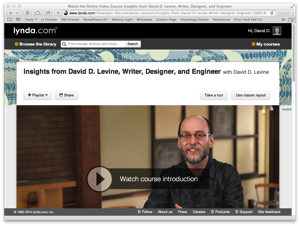This article provides an explanation I haven’t seen before for the difficult-to-wrap-one’s-head-around concept that in quantum mechanics it’s “observation” that causes the quantum wave form to collapse.
“…if you take a picture of an electron, its probability cloud evaporates and leaves it at one exact place. The light that bounced off the electron to hit your camera forced the electron to appear! The resolution to this troubling idea is that if you leave the light off, no photons hit the electron. The watching camera sees nothing, the electron remains ethereal. The electron will still be forced to resolve in a lit place while watched by a camera with its lens cap on.” (emphasis added)
Or, to put it another way, it’s not “observation” but “interaction” that collapses the wave form. If a particle isn’t interacting with any other particle, it might be anywhere. Only when two particles bounce off each other (or otherwise interact) do their positions and states become clear.
I find this explanation compelling. It makes the whole concept much more comprehensible to me. But it also implies that the whole concept of quantum uncertainty is an entirely theoretical mathematical abstraction, because in reality every particle is interacting with other particles nearly constantly. Even a single hydrogen atom floating in the near-vacuum of interplanetary space is struck by photons from the sun and interacts gravitationally with the planets.
If my understanding is correct, quantum uncertainty never really happens in real life — all particles are in a constant state of waveform collapse. This makes quantum uncertainty as relevant to the real world as those massless, frictionless ropes we use in physics problems. (By which I mean that it is a useful theory with great predictive power, but doesn’t actually describe anything that exists in the real world.)
If you are familiar with quantum theory, does this explanation and its implications match your understanding? If not, can you help me to understand where it differs?
Also, if you are familiar with the history of quantum theory, do you know why the term “observation” was used rather than “interaction”? Because if my understanding of this explanation is correct, the term “interaction” would be a much clearer way of explaining what’s happening (and would have avoided a lot of the meaningless woo-woo that’s attached itself to the term “quantum physics”).
 I’m very pleased to announce that I will be the Fan Guest of Honor at
I’m very pleased to announce that I will be the Fan Guest of Honor at  Here’s Lynda’s description of the course: “David D. Levine has worn many hats in his long career: technical writer, interaction designer, software engineer, and award-winning science fiction author. His career path, with its ups, downs, and redirections, mirrors the one many job seekers find themselves on today. Find out how he turned a BA in architecture into a technical writing career, and, a decade later, transformed himself into an interaction designer and, finally, a software engineer. And see how, even after his retirement, he found ways to use his technical background to write science fiction stories. This course breaks down the different stages in David’s career into sections where he answers questions and offers hard-won advice to job hunters. Dive in and get insights from an expert—in more than one industry!”
Here’s Lynda’s description of the course: “David D. Levine has worn many hats in his long career: technical writer, interaction designer, software engineer, and award-winning science fiction author. His career path, with its ups, downs, and redirections, mirrors the one many job seekers find themselves on today. Find out how he turned a BA in architecture into a technical writing career, and, a decade later, transformed himself into an interaction designer and, finally, a software engineer. And see how, even after his retirement, he found ways to use his technical background to write science fiction stories. This course breaks down the different stages in David’s career into sections where he answers questions and offers hard-won advice to job hunters. Dive in and get insights from an expert—in more than one industry!” Topics covered in the course include:
Topics covered in the course include:

Recent Comments